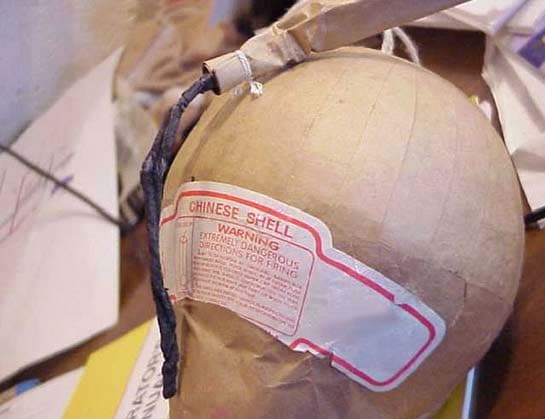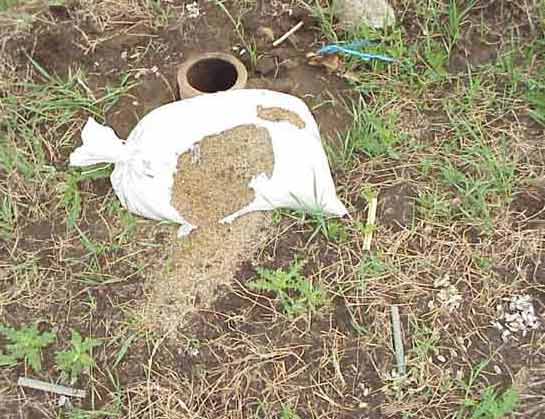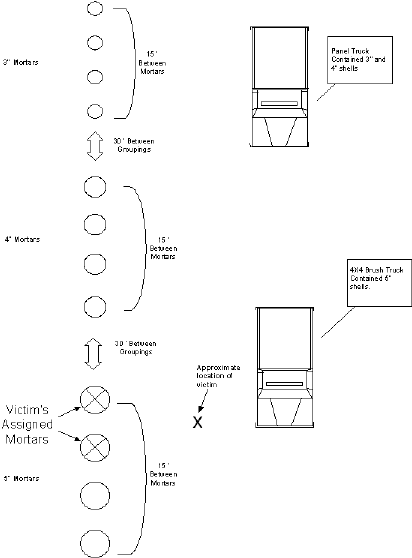Volunteer Fire Fighter Dies Due to Inadvertent Fireworks Discharge - North Dakota
 Death in the Line of Duty…A summary of a NIOSH fire fighter fatality investigation
Death in the Line of Duty…A summary of a NIOSH fire fighter fatality investigation
F2002-31 Date Released: January 29, 2003
SUMMARY
On July 5, 2002, a 44-year-old male volunteer fire fighter (the victim) was killed while loading shells into mortars at a public fireworks display. Approximately 40 minutes into the show, the victim suddenly yelled and ran from the mortar, reportedly covered with sparks and trying to brush something from his clothing. Seconds later, a shell exploded, causing him bodily injury, and he fell. He was transported to a local hospital where he was pronounced dead later that night.
NIOSH investigators concluded that, to minimize the risk of similar incidents, fire departments should
- ensure that safety caps protecting the fuse on fireworks shells are not removed until immediately before the shell is to be fired and are removed only by the shooter
- ensure that all fire fighters participating in public fireworks displays are fully trained in the proper performance of their assigned tasks and that they are educated with regard to safety hazards
- ensure that mortars are not reloaded/fired more than seven times during a performance to prevent mortar disintegration
- develop, implement and enforce standard operating guidelines (SOGs) for the operation of fireworks displays
INTRODUCTION
On July 5, 2002, a 44-year-old male volunteer fire fighter (the victim) was killed while loading shells into mortars at a public fireworks display. On July 10, 2002, the U.S. Fire Administration (USFA) notified the National Institute for Occupational Safety and Health (NIOSH) of this fatality. On September 17, 2002, two safety and occupational health specialists from the NIOSH Fire Fighter Fatality Investigation and Prevention Program investigated the incident.
The NIOSH investigators met with the Chief of the Department and the County Sheriff who investigated the incident, and they reviewed the police incident reports and photographs and the report of death from the State Forensic Medical Examiner.
This volunteer department has 25 uniformed personnel and serves a population of approximately 500 in a rural area of about 244 square miles. The 44-year-old victim had been a volunteer fire fighter for 2 years.
The fire chief conducted training on safety requirements and proper fireworks discharge procedures before beginning the display. Volunteers familiarized themselves with locations of the mortars and proper placement of the shells into the mortars before lighting and discharge. Positions and duties were assigned by the chief.
Weather: The air temperature was 68 to 71 degrees Fahrenheit, with a relative humidity ranging from 51 to 58%, and a wind speed of 6 mph gusting to 15 mph. Weather conditions did not appear to be a factor in this incident.
INVESTIGATION
On July 5, 2002, 10 members of the volunteer fire department set off aerial fireworks for a centennial celebration. Twelve in-ground mortar casings were placed in three groups of four casings. Three-, four-, and five-inch aerial shells were used with one group of four mortars for each of the three sizes of shells (Photo 1). The mortars, which were constructed of heavy, rolled cardboard tubing, were buried below ground approximately 2 feet with about 4 inches remaining above ground (Photo 2). Mortars were placed approximately 15 feet apart within each group of four with approximately 30 feet separating each group of four mortars (Diagram). A sandbag was placed next to each mortar (Photo 2). Boxes containing unspent shells were stored in one of the fire department vehicles located about 40 feet behind the row of mortars.
Each loader was assigned two mortars (one size shell).a The victim was assigned to load two 5-inch mortars (Diagram). There were two shooters,b each of whom lit half of the shells, starting in the middle of the row and working outward. The procedure was for each loader to (1) pick up two unspent shells from the person assigned to the bulk storage area, (2) walk to the assigned mortars and load them, (3) remove the safety cap, (4) move away while the shells were lit, and (5) following successful discharge, repeat the same procedure. Starting in the middle of the line, the shooters lit each of six fuses with a fuseec attached to a broom handle. The loaders waited for the sound of the explosion and/or the flash as the shell was propelled from the mortar and then proceeded to reload their mortars. Note: Safety capsd for the shells were removed either by the individual handing out the unspent shells or by the loader.
Approximately 40 minutes into the display, near the end of the show, witnesses heard the victim yell and saw him run toward one of the trucks (storage area for unspent shells). He reportedly was covered in sparks and appeared to be trying to brush something from his clothing. Seconds later a shell (presumably under the victim’s left arm) exploded and he fell. Note: A witness reported to NIOSH that just before the incident, the victim had been down on one knee loading the first of his two mortars. Fire fighters rushed to help the victim and attended to him until the ambulance arrived. He was transported to a local hospital where he was pronounced dead several hours later.
CAUSE OF DEATH
The cause of death as listed by the medical examiner was blunt force injuries of the chest and left upper extremity due to fireworks discharge.
RECOMMENDATIONS/DISCUSSION
Recommendation #1: Fire departments should ensure that safety caps protecting the fuse on fireworks shells are not removed until immediately before the shell is to be fired and are removed only by the shooter. 1
Discussion: As stated in NFPA 1123, § 1.4.43, “safety caps are placed over the end of the fuse of a fireworks device to protect it from damage and accidental ignition.” During this incident, safety caps were removed either by the loaders or by the individuals positioned at the staging area handing out shells. It is possible that the fuse on one of the victim’s shells (which he may have had under his left arm), accidentally was ignited by embers from spent shells lying on the ground.
Recommendation #2: Fire departments should ensure that all fire fighters participating in public fireworks displays are fully trained in the proper performance of their assigned tasks and that they are educated with regard to safety hazards. 2
Discussion: Approximately 1 hour before the fireworks display, the Chief provided training to the fire fighters following instructions that came with the fireworks. Training should include applicable State, federal and consensus standards, particularly NFPA 1123, Code for Fireworks Display, 2000 Edition, plus any relevant departmental requirements. NFPA 1123, § 5.1.3.2 states that “The operatore shall be responsible for ensuring that all assistants are fully trained in the proper performance of their assigned tasks and that they are educated with regard to safety hazards.”
Recommendation #3: Fire departments should ensure that mortars are not reloaded/fired more than seven times during a performance to prevent mortar disintegration. 3
Discussion: According to NFPA 1123, § 2.3.4, “mortars of any type 6 in. (152 mm) in diameter or less shall be permitted to be reloaded and fired up to 7 times during a performance.f” Based on the length of the performance, the time it took to light the various shells, lists delineating the original contents of the boxes of shells, plus a listing of the type and number of shells remaining after the incident, the number of shells used for this display exceeded 400. Thus, each mortar was (re)loaded more than 30 times.
Recommendation #4: Fire departments should develop, implement and enforce standard operating guidelines (SOGs) for the operation of fireworks displays. 3–5
Discussion: The department in this incident had no standard operating guidelines (SOGs) regarding the operation of fireworks displays. At a minimum, the relevant provisions in NFPA 1123, Code for Fireworks Display, 2000 Edition, should be included in any SOG.
REFERENCES
- NFPA [2000]. NFPA 1123, § 5.2.6.1, Code for Fireworks Display, 2000 Edition, Quincy, MA: National Fire Protection Association.
- NFPA [2000]. NFPA 1123, & 5.1.3.2, Code for Fireworks Display, 2000 Edition, Quincy, MA: National Fire Protection Association.
- NFPA [2000]. NFPA 1123, & 2.3.4, Code for Fireworks Display, 2000 Edition, Quincy, MA: National Fire Protection Association.
- Foley SN, ed. [1998]. Fire department occupational health and safety standards handbook. 1st ed. Quincy, MA: National Fire Protection Association.
- Brunacini AV [1985]. Standard operating procedures. In: Fire command. College Park, MD: YBS Productions.
INVESTIGATOR INFORMATION
This incident was investigated by Linda Frederick and Virginia Lutz, Safety and Occupational Health Specialists, NIOSH, Division of Safety Research, Surveillance and Field Investigation Branch.
a One person loaded all of the 4-inch mortars.
b Member of the fireworks display crew who ignites the fireworks, either manually or by electrical means.
c A highway distress flare, sometimes used to ignite fireworks at outdoor fireworks displays.
d A paper tube, closed at one end, that is placed over the end of the fuse of a fireworks device to protect it from damage and accidental ignition.
e Operator: “The person with overall responsibility for the safety, setup, and discharge of an outdoor fireworks display” (NFPA 1123, section 1.4.37).
f Exception: “There shall be no limit to the number of times a steel mortar 6 in. (152 mm) or less is permitted to be reloaded.”

Photo 1. Example of Shell Used in Fireworks Display

Photo 2. Picture of Mortar and Sandbag Used in Fireworks Display

Diagram. Layout of Mortars and Storage Areas
This page was last updated on 02/07/03
